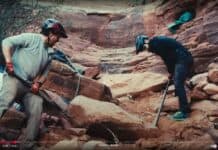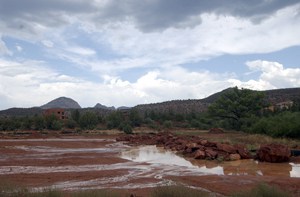Complaints from community activists caused the Army Corps of Engineers to issue a letter Feb. 22 requiring BySynergy to apply for a special permit, effectively stopping development in certain sections of the Bella Terra subdivision.
 ?Anytime a developer might impact … jurisdictional waters, they must apply for a permit.?
?Anytime a developer might impact … jurisdictional waters, they must apply for a permit.?
Howard Shanker,
Sierra Club attorney
Larson Newspapers
________________
Complaints from community activists caused the Army Corps of Engineers to issue a letter Feb. 22 requiring BySynergy to apply for a special permit, effectively stopping development in certain sections of the Bella Terra subdivision.
Spokesmen for the Sierra Club and the Red Rock Rural Community Association claimed a victory in their effort to stop development in the area located next to Red Rock Loop Road.
BySynergy President Michael Zito said the ACE letter had no impact on Bella Terra?s plans.
After providing the ACE with information from several experts, the RRRCA and the Sierra Club have succeeded in making BySynergy, a development firm, file a new raft of forms to continue work on the subdivision.
Paul Trotta, of SWCA Environmental Consultants, and Paul Lindberg, geological engineer, provided the environmental groups with evidence that Bella Terra was in violation of the Clean Water Act.
RRRCA Vice President Brian Meyers passed the evidence on to the ACE.
In a letter to Howard Shanker, the attorney representing the environmental groups, the ACE stated, ?BySynergy has been requested to submit an after-the-fact Section 404 permit application.?
Zito said, ?All the Section 404 permit forms have been submitted or are being submitted today [Thursday, March 1]. We have complied with everything.?
Zito said Bella Terra already submitted the cultural and
biological resource reports to ACE. These reports cover archeological, habitat, Yavapai County endangered species and historical structures, according to Daisy Eldridge, an ACE spokeswoman.
Bella Terra ?tried to avoid filing for a Section 404 permit because they wanted to avoid the studies associated with that process,? Myers said.
Under the Clean Water Act, ?anytime a developer might impact or is perceived to impact jurisdictional waters, they must apply for a permit under Section 404? of the Act, according to Tom Slaback, chair of the Yavapai Group of the Grand Canyon Chapter of the Sierra Club.
A Section 404 permit process often requires archeological, historical structure and endangered species act studies.
?The Corps action is a step in the right direction,? said Carole Piszczek-Sheffield, vice chair of the Grand Canyon Chapter of the Sierra Club.
?We never applied for a Section 404 permit because we never thought it was necessary and neither did the Army Corps of engineer inspectors,? Zito said.
You don?t have to apply for a permit if all you?re doing is maintaining or repairing a ditch, Zito said.
Zito agrees an extension of the ditch work probably triggered the Section 404 violation in that area.
?We are talking about 320 square feet. An 80 foot by 4 foot section,? he said.
The Red Rock Ditch, the waterway in question, falls under the jurisdiction of the Clean Water Act, the ACE reported.
The RRRCA is made up of property owners and residents who live on the Red Rock Loop Road and other rural portions of Oak Creek outside Sedona.
The Sierra Club claims 13,000 member in Arizona.


















